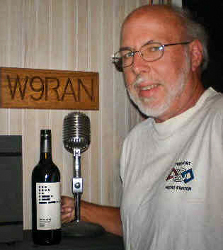
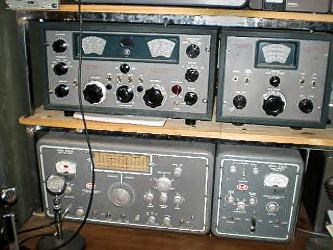
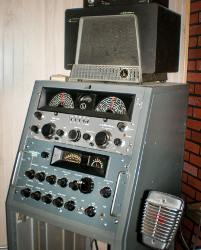
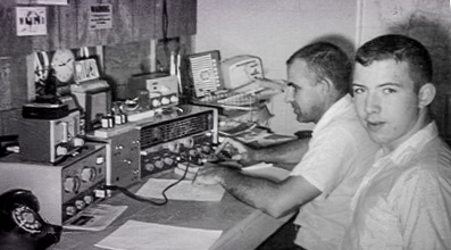
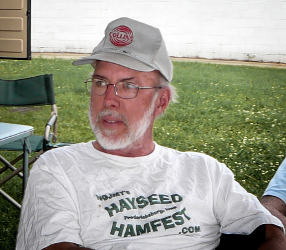
![]() The Spilsbury and Tindall PRT-20
The Spilsbury and Tindall PRT-20
"bush radios" in Canada where Spilsbury is located (Vancouver area) and for logging, oil exploration, forest-fire fighting, etc
in the late 50s-early 60s until SSB versions replaced them. Click here for more info and better pictures. ⇰ Bob (page opens in new browser window)


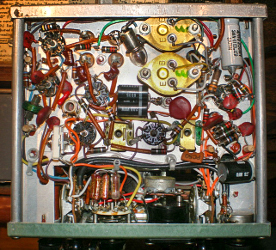
The FP-1 is all solid-state, a big plus for battery operation in the field, and being a mid-1960s design uses germanium transistors, including a pair of 2N301As as the modulator, a transisitor I remember scavenging from hybrid car radios as a young ham! The PA uses two 2N3879 transistors in a push-pull neutralized output stage which uses a toroidal inductor having 11 taps and a second inductor for antenna tuning/matching. Two output connectors are provided with a switch to select between taps that have been set for mobile (presumably close to a 50 ohm load) and as a loading coil for a portable whip. Unlike some similar sets, the FP-1 uses an external battery, which I see as a plus given how often battery leakage causes damage to portable radios. As the pics show, the interior of the FP-1 is very clean and quite interesting to look at, since many of the locally-sourced components look a bit different from the ones we're more accustomed to seeing. The frequency range is 2-5 Mhz.
| Picture from hfradio.com.au | FP-1 Radio Only | Internal View (Top) | Internal View (Bottom) |
|---|---|---|---|
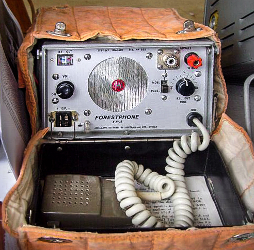 |
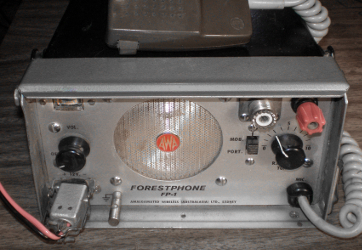 |
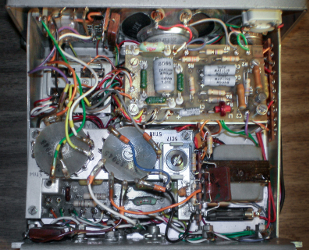 |
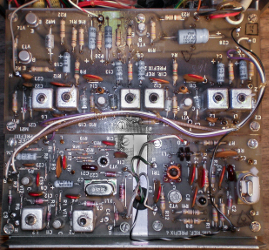 |
The receiver is a single-conversion superhet that requires a crystal 455Khz above the desired operating frequency and is very sensitive (Under 2µV). Fortunately for me, the radio came equipped with transmit and receive crystals for 3888 Khz, which the seller said was outside the AM allocation in Oz and thus he never was able to use the radio on the air. It took only a slight tweaking of the IF cans to peak it up 3Khz away, on 3885. For transmit, I merely substituted one of the inexpensive HC-49/U crystals from N4ESS, which did not oscillate to begin with. Fortunately again, the radio came with a complete technical manual where I saw that a 33pF cap had been placed in series with the crystal in the Colpitts oscillator, and which was reducing the feedback too much. Bypassing this cap brought the oscillator to life with full output of 12-15 watts with 13.8V supply, or a solid 10 watts from a 12 volt battery. Transmit current drain is as high as 3.8A but the receiver draws only 20ma in standby yet produces lots of audio. For this reason we plan to have the Forestphone "guarding 3885" during next year's Hamvention at Xenia, OH ➙ so calls on 3885 AM might just be heard!
I found little information about the FP-1 online but the pic shows one with the cover and canvas carry bag which I do not have, obtained from hfradio.com.au
Small AM (and later SSB) field radios like the Forestphone were the mainstay of the Forests Commission in Australia until the mid-70 when VHF took over. But HF still plays a role in remote regions of the world, and when used with a decent antenna, radios like this are still capable of communication over several hundred miles.
![]() Virtual Radar from a Digital TV Dongle
Virtual Radar from a Digital TV Dongle
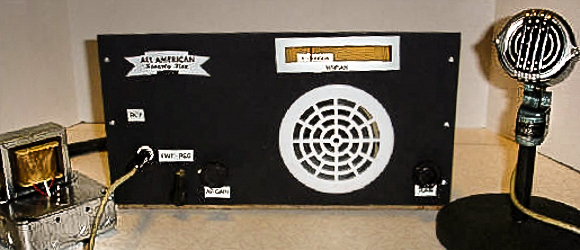

The AA75 conversion consists of adding an external power supply to eliminate the hot chassis shock hazard and building a simple crystal controlled transmitter using a 35L6 that replaces the original rectifier tube in the series filament string. Re-tuning the receiver from the BC band to 75 meters provides about the same performance as an S-38 type receiver which is good enough to hear any station that can receive the AA75s QRP signal.
I was motivated to try the AA75 conversion after finding an AA5 radio with a hopelessly broken plastic cabinet in an antique shop for $5. As a result, this rig is housed in a homebrew cabinet made of scrap wood and plastic (note how the dial has been carefully calibrated for AM operation!) I hope others will be motivated to try similar conversions and with their own innovations. Since the basic AA5 circuit was used by hundreds of manufacturers, the AA5 was possibly the original Open Source Design!
Unfortunately, a couple of errors crept into the 35L6 transmitter schematic that appears on page 19 of the article, and I urge anyone wishing to give this idea a try to use the following corrected version of 10/13 instead of the one published in ER.

![]()
![]() Return to ⇰ Members page
Return to ⇰ Members page
![]() Go to ⇰ MCRN Picture Book
Go to ⇰ MCRN Picture Book
![]() Return to ⇰ Home
Return to ⇰ Home
![]() Last update ⇰ December 14, 2017
Last update ⇰ December 14, 2017